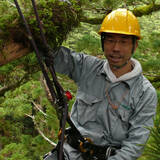Effects of Climate Change on Ecophysiology of Managed Forests
A special issue of Forests (ISSN 1999-4907). This special issue belongs to the section "Forest Ecophysiology and Biology".
Deadline for manuscript submissions: closed (31 January 2022) | Viewed by 2172
Special Issue Editors
Interests: physiological ecology of trees; photosynthetic light use efficiency of conifer shoots; forest community ecology; structural development of the forest canopy; population ecology of trees: focusing on spatial processes and crown competition; conservation, restoration and management of urban forests
Special Issue Information
Dear Colleagues,
In the face of unpredictable climate change, there is much uncertainty regarding the future of managed forests. Will existing forests continue to be productive in a warmer world? Will the seedlings planted now survive to harvesting age? How will climate change affect the phenology of trees, and what impacts will this have on the production of related goods and services? Will current management plans be effective for flood control when precipitation patterns change? As our society shifts toward climate-change adaptation, there is an urgent need to develop basic knowledge and management techniques for adapting managed forests to future climate for the sake of forestry, wood production, and ecosystem services, including carbon sequestration to counter global warming. In this Special Issue of Forests, we seek research conducted in managed forests in the context of climate change. We welcome research articles focusing on the development of new cultivars or silvicultural techniques for climate-change adaptation, monitoring and/or predicting effects of climate change on plantations, as well as impacts of climate change on various socioeconomic aspects of forestry, such as timber production, wood products, forestry labor, forest recreation, urban forests, etc. Our aim is for this Special Issue to serve as a broad collection of current knowledge on the future of managed forests around the world.
Dr. H. Roaki Ishii
Prof. Dr. Thomas M. Hinckley
Guest Editors
Manuscript Submission Information
Manuscripts should be submitted online at www.mdpi.com by registering and logging in to this website. Once you are registered, click here to go to the submission form. Manuscripts can be submitted until the deadline. All submissions that pass pre-check are peer-reviewed. Accepted papers will be published continuously in the journal (as soon as accepted) and will be listed together on the special issue website. Research articles, review articles as well as short communications are invited. For planned papers, a title and short abstract (about 100 words) can be sent to the Editorial Office for announcement on this website.
Submitted manuscripts should not have been published previously, nor be under consideration for publication elsewhere (except conference proceedings papers). All manuscripts are thoroughly refereed through a single-blind peer-review process. A guide for authors and other relevant information for submission of manuscripts is available on the Instructions for Authors page. Forests is an international peer-reviewed open access monthly journal published by MDPI.
Please visit the Instructions for Authors page before submitting a manuscript. The Article Processing Charge (APC) for publication in this open access journal is 2600 CHF (Swiss Francs). Submitted papers should be well formatted and use good English. Authors may use MDPI's English editing service prior to publication or during author revisions.
Keywords
- global warming
- plantation forest
- timber production
- silviculture
- tree breeding






